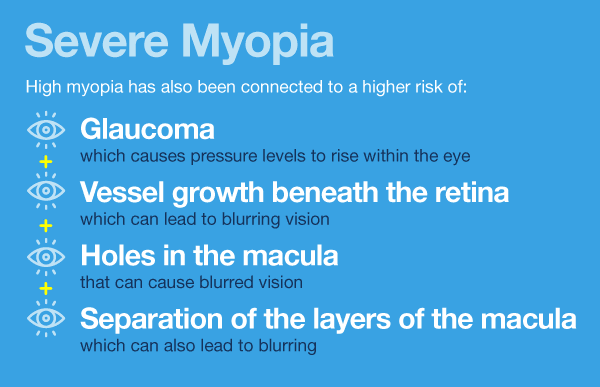What Qualifies as Extreme Nearsightedness?
Home / Nearsightedness (Myopia) /
Last Updated:
Table of Contents
Extreme nearsightedness is the result of the eyeball being anywhere from 1 mm to 4 mm longer than it should be, causing a greater degree of myopia. It is an inherited condition, and it can be diagnosed in early childhood.
If left untreated, high myopia can cause other eye conditions and sight problems. Treatments for extreme nearsightedness include special lenses as well as a greater degree of home-based eye and vision care.

What Is Myopia?
Nearsightedness, or myopia, is a condition where the eye’s optical system does not focus incoming light rays directly on the retinal surface, but instead focuses them in front of the retina. Myopia is a very common condition, often caused by an eye that is abnormally long or if the eye has irregularities in the lens or the cornea.
Myopia can easily be corrected with refractive surgery like LASIK, eyeglasses, or contact lenses.
You deserve clear vision. We can help.
With 135+ locations and over 2.5 million procedures performed, our board-certified eye surgeons deliver results you can trust. Your journey to better vision starts here.

High Myopia or Extreme Nearsightedness
In rare cases, people might have high myopia or extreme nearsightedness (also known as high-degree nearsightedness). This is an inherited condition, and it occurs when the eyeball grows longer than it should (an axial length of greater than 26.5 mm, when the standard axial length of the eye is between 22 mm and 25 mm) or when the cornea in the eye is too steep. This affects how and where incoming light is focused.
Symptoms of extreme nearsightedness include blurred vision, increased difficulty in focusing on objects, and other forms of gradual vision loss.
A refractive error greater than -6 is when an optometrist might diagnose high myopia in a patient. Low myopia can have a refractive error as low as -0.25, while moderate myopia caps out at -5.75.
If left untreated and with age, high myopia can progressively worsen to a greater degree of refractive error. The condition typically plateaus by a patient’s 30th birthday.
Depending on the severity of the refractive error, high myopia can be corrected with special glasses or contact lenses, or through the use of refractive surgery.
Certainly! Apologies for the confusion. Based on your guidance, here’s a refined version of the section:
What Is the Highest Myopia?
While the term “high myopia” typically refers to a refractive error greater than -6, there isn’t a universally agreed-upon threshold for what could be termed the “highest” myopia. A refractive error of -10 might be considered extremely high, but the spectrum of myopia doesn’t have a definitive upper limit.
In rare and extreme cases, record-setting myopia levels have been documented, far surpassing the -10 mark. However, these instances are uncommon and fall well outside the norm even for high myopia. The categorization of myopia often focuses on the underlying causes and the effects on vision rather than defining specific bounds for what might constitute the highest level.
The understanding of myopia’s varying degrees continues to evolve, and as researchers delve into the complexities of this condition, the terminology and categorizations may further develop. For now, high myopia remains a broadly defined category encompassing a wide and sometimes surprising range of refractive errors, each requiring tailored approaches to treatment and management.
You deserve clear vision. We can help.
With 135+ locations and over 2.5 million procedures performed, our board-certified eye surgeons deliver results you can trust. Your journey to better vision starts here.
Causes & Prevalence
What can cause high myopia? In some cases, it is an inherited genetic condition. If one or both parents have nearsightedness, it is likely that their child will also be at risk for high myopia.
The earlier in childhood that myopia develops, the greater the progression of myopia, to the point where the likelihood of developing high myopia becomes significant.
In about half of the general population, the progression of myopia stabilizes around one’s 15th birthday, but many people will continue to experience worsening nearsightedness until age 24.
Other Health Concerns
High myopia does not end in vision loss on its own, but the ongoing lengthening of the eyeball thins the retina and other tissues in the eye, making them more susceptible to other health problems and physical damage.
People who have high myopia can also develop pathological myopia, also known as degenerative myopia. This is a rare condition where high myopia leads to legal blindness, but it happens in less than 3 percent of the general population.
Having high myopia can increase the risk of developing more severe sight conditions later in life, including but not limited to cataracts, glaucoma, and detached retinas.
Without treatment, high myopia can eventually lead to such a degree of refractive error that corrective lenses cannot provide clearer sight.
Potential Treatments & Protection
Today, more and more people are being diagnosed with high myopia at a greater rate than in the past. This has led ophthalmologists and other researchers to attempt different methods of slowing its progression.
Low-dose atropine, for example, has shown success in slowing the progression of myopia as well as reducing the elongation of the axial length.

A more controversial method is orthokeratology, where contact lenses are worn overnight to induce the eye to gradually reduce its axial length.
Bifocals, multifocal contact lenses, and progressive lenses are other options for treating high myopia. Doctors further recommend spending more time outdoors and limiting screen time to slow down myopic progression.
People who have high myopia should receive regular dilated eye exams to watch for retinal holes or retinal tears, both of which can result in retinal detachment.
High myopia, or extreme nearsightedness, is associated with an increased risk of other eye conditions over a patient’s lifetime. Further issues that may arise include the growth of abnormal blood vessels beneath the retina as well as changes to the vitreous cavity, located in the center of the eyeball.
You deserve clear vision. We can help.
With 135+ locations and over 2.5 million procedures performed, our board-certified eye surgeons deliver results you can trust. Your journey to better vision starts here.
References
- Nearsightedness: What Is Myopia? (September 2022) American Academy of Ophthalmology.
- Epidemiology of Myopia. (January 2014). Eye.
- Insight into the Molecular Genetics of Myopia. (2017). Molecular Vision.
- Associations of High Myopia in Childhood. (February 2001). Eye.
- Pathologic Myopia: An Overview of the Current Understanding and Interventions. (June 2020). Global Health and Medicine.
- High Myopia and Its Risks. (2019). Community Eye Health.
This content is for informational purposes only. It may have been reviewed by a licensed physician, but is not intended to serve as a substitute for professional medical advice. Always consult your healthcare provider with any health concerns. For more, read our Privacy Policy and Editorial Policy.